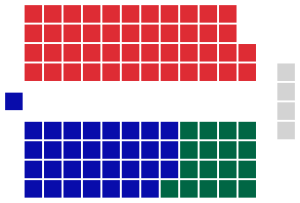New South Wales state election, 1991
|
|
||||||||||||||||||||||||||||||||||
|---|---|---|---|---|---|---|---|---|---|---|---|---|---|---|---|---|---|---|---|---|---|---|---|---|---|---|---|---|---|---|---|---|---|---|
|
||||||||||||||||||||||||||||||||||
|
All 99 seats in the New South Wales Legislative Assembly and 21 (of the 42) seats in the New South Wales Legislative Council 50 Assembly seats were needed for a majority |
||||||||||||||||||||||||||||||||||
|
||||||||||||||||||||||||||||||||||

Legislative Assembly after the election
|
||||||||||||||||||||||||||||||||||
|
||||||||||||||||||||||||||||||||||
Nick Greiner
Liberal/National coalition
Nick Greiner
Liberal/National coalition
Elections to the 50th Parliament of New South Wales were held on Saturday 25 May 1991. All seats in the Legislative Assembly and half the seats in the Legislative Council were up for election. The Liberal-National Coalition government of Premier Nick Greiner, which enjoyed a considerable majority following their landslide win at the 1988 election, was seeking a second term in office against new Labor Opposition Leader Bob Carr.
The government had reduced the number of lower house seats from 109 to 99 for the 1991 election, reversing an increase approved by the Unsworth Labor government.
The 1988 election generated a two-party preferred swing to the Coalition of 8.4% and saw the Labor Party record its lowest primary vote in half a century. This was a clear rejection of the Unsworth Government, although it was less clear whether the electorate was endorsing the full range of Coalition policies. Qualms about the meaning of its mandate were clearly of little concern to the new Government under Nick Greiner which immediately began introducing wide ranging reforms to the New South Wales public sector.
...
Wikipedia


